SWEDISH SOUTH ASIAN STUDIES NETWORK
New books connected to South Asia research:
This list is not a comprehensive one. It only gives some recommendations by ourselves or by other reliable sources, e g from the Norwegian NoFSA-net and the Brittish BASAS Bulletin. Personal comments marked by italics.
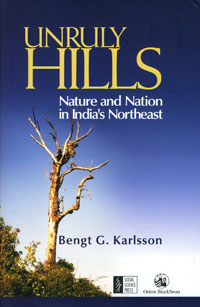 Unruly Hills: Nature and Nation in India’s Northeast, by Beppe Karlsson, Dept. of Social Anthropology, Stockholm University. This book summarises the 10 year old research project on the politics of indigenousness and nature in India. More particularly, it related to the struggle over forests and natural resources in Meghalaya, a small hill state of about two million people situated in the north-eastern region, where the majority of the population (about 85 %) are indigenous peoples or so-called ”scheduled tribes”; the main ones being the Khasi, Jaintia and Garo people. The focus of the project was to investigate discourses or regimes of nature and how a number of actors perceive, engage with and claim nature. Social Science Press/Orient Black Swan, January 2011.
Unruly Hills: Nature and Nation in India’s Northeast, by Beppe Karlsson, Dept. of Social Anthropology, Stockholm University. This book summarises the 10 year old research project on the politics of indigenousness and nature in India. More particularly, it related to the struggle over forests and natural resources in Meghalaya, a small hill state of about two million people situated in the north-eastern region, where the majority of the population (about 85 %) are indigenous peoples or so-called ”scheduled tribes”; the main ones being the Khasi, Jaintia and Garo people. The focus of the project was to investigate discourses or regimes of nature and how a number of actors perceive, engage with and claim nature. Social Science Press/Orient Black Swan, January 2011. ![]()
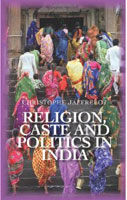 Religion, Caste & Politics in India by Christophe Jaffrelot, Centre d' Etudes et de Recherches Internationales (CERI-Sciences Po/CNRS) in Paris. After Independence the Nehruvian approach to socialism in India rested upon three pillars: secularism and democracy in the political domain; state intervention in the economy; and diplomatic Non-Alignment mitigated by pro-Soviet leanings after the 1960s. These features defined the 'Indian model', and even the country's political identity. From this starting point Christophe Jaffrelot explores the manner in which some of these dimensions have been transformed over the course of time, more especially since the 1980-90s. The world's largest democracy has sustained itself by making more room, not only for the vernacular politicians of the linguistic states, but also for Dalits and OBCs, at least after the Mandal Commission report. But the simultaneous-and related-rise of Hindu nationalism has put the minorities-and secularism-on the defensive, and in many ways the rule of law is on trial too. The liberalisaton of the economy has resulted in growth but not necessarily in development: while the new middle class is changing the face of urban India, the rural areas lag behind and inequalities have become more acute. India has also acquired a new global status, that of an emerging power seeking new political and economic partnerships in Asia and in the West, where the United States remains the first choice of the Indian middle class. The traditional Nehruvian system is giving way to a less cohesive but a more active India, a country that has already become what it is against all the odds. Christophe Jaffrelot tracks India's tumultuous journey of recent decades, exploring the role of religion, caste and politics in weaving the fabric of a modern democratic state. Hurst, 2010.
Religion, Caste & Politics in India by Christophe Jaffrelot, Centre d' Etudes et de Recherches Internationales (CERI-Sciences Po/CNRS) in Paris. After Independence the Nehruvian approach to socialism in India rested upon three pillars: secularism and democracy in the political domain; state intervention in the economy; and diplomatic Non-Alignment mitigated by pro-Soviet leanings after the 1960s. These features defined the 'Indian model', and even the country's political identity. From this starting point Christophe Jaffrelot explores the manner in which some of these dimensions have been transformed over the course of time, more especially since the 1980-90s. The world's largest democracy has sustained itself by making more room, not only for the vernacular politicians of the linguistic states, but also for Dalits and OBCs, at least after the Mandal Commission report. But the simultaneous-and related-rise of Hindu nationalism has put the minorities-and secularism-on the defensive, and in many ways the rule of law is on trial too. The liberalisaton of the economy has resulted in growth but not necessarily in development: while the new middle class is changing the face of urban India, the rural areas lag behind and inequalities have become more acute. India has also acquired a new global status, that of an emerging power seeking new political and economic partnerships in Asia and in the West, where the United States remains the first choice of the Indian middle class. The traditional Nehruvian system is giving way to a less cohesive but a more active India, a country that has already become what it is against all the odds. Christophe Jaffrelot tracks India's tumultuous journey of recent decades, exploring the role of religion, caste and politics in weaving the fabric of a modern democratic state. Hurst, 2010.
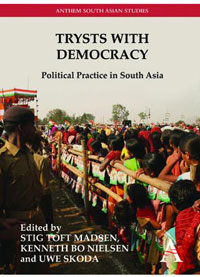 Trysts with Democracy.
Political Practice in South Asia.
Edited by Scandinavian researchers Stig Toft Madsen, Kenneth Bo Nielsen and Uwe Skoda. A cross-disciplinary approach to the diverse and entangled political and democratic practices of South Asia.
This volume addresses the current configuration of democratic politics in South Asia from a cross-disciplinary perspective. The essays seek to examine the larger questions of how democratic values are embedded in social and political institutions, and how localised and everyday political values inform the multiple ways in which democracy is understood and practised. One of the strengths of this collection is the fact that it does not seek to provide answers to these questions from within one academic discipline only, but rather brings together scholars with backgrounds in a variety of social science disciplines and the humanities. Anthem Press March 2011.
Trysts with Democracy.
Political Practice in South Asia.
Edited by Scandinavian researchers Stig Toft Madsen, Kenneth Bo Nielsen and Uwe Skoda. A cross-disciplinary approach to the diverse and entangled political and democratic practices of South Asia.
This volume addresses the current configuration of democratic politics in South Asia from a cross-disciplinary perspective. The essays seek to examine the larger questions of how democratic values are embedded in social and political institutions, and how localised and everyday political values inform the multiple ways in which democracy is understood and practised. One of the strengths of this collection is the fact that it does not seek to provide answers to these questions from within one academic discipline only, but rather brings together scholars with backgrounds in a variety of social science disciplines and the humanities. Anthem Press March 2011. ![]()
The Politics of Religion in South and Southeast Asia. Edited by Ishtiaq Ahmed, Professor Emeritus at the Dept. of Political Science, Stockholm University. The notion of a ‘politics of religion’ refers to the increasing role that religion plays in the politics of the contemporary world. This book presents comparative country case studies on the politics of religion in South and South Asia, including India, Pakistan and Indonesia. The politics of religion calls into question the relevance of modernist notions of secularism and democracy, with the emphasis instead on going back to indigenous roots in search of authentic ideologies and models of state and nation building. Within the context of the individual countries, chapters focus on the consequences that politics of religion has on inclusive nation-building, democracy and the rights of individuals, minorities and women. Routledge May 2011. ![]()
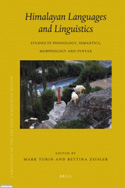 Himalayan Languages and Linguistics. Studies in Phonology, Semantics, Morphology and Syntax, by Mark Turin, University of Cambridge where he directs the Digital Himalaya and World Oral Literature Projects, and
Bettina Zeisler, Free University Berlin. The book gathers together nine outstanding and original contributions on the Tibeto-Burman and Indo-Aryan languages of this important and culturally diverse mountainous area. Filling a marked gap in our understanding of the languages of this underdocumented region, the collection offers a snapshot of the state of the field of Himalayan language research and linguistic comparison. Draws on primary fieldwork in China, India, Nepal and Pakistan. Brill's Tibetan Studies Library 2011.
Himalayan Languages and Linguistics. Studies in Phonology, Semantics, Morphology and Syntax, by Mark Turin, University of Cambridge where he directs the Digital Himalaya and World Oral Literature Projects, and
Bettina Zeisler, Free University Berlin. The book gathers together nine outstanding and original contributions on the Tibeto-Burman and Indo-Aryan languages of this important and culturally diverse mountainous area. Filling a marked gap in our understanding of the languages of this underdocumented region, the collection offers a snapshot of the state of the field of Himalayan language research and linguistic comparison. Draws on primary fieldwork in China, India, Nepal and Pakistan. Brill's Tibetan Studies Library 2011. ![]()
Pakistan: Beyond the ‘Crisis State', a collection of articles by Pakistani scholars offering an “insiders' perspective” on Pakistan, edited by Maleeha Lodhi, Pakistani Ambassador in Washington from 1999 to 2002 and then in London from 2003 to 2008. According to Ms Lodhi, it is intended to challenge the “doomsday scenarios” about Pakistan painted by “outsiders”. Hurst & Company, May 2011. ![]()
The Politics of Belonging in India.
Becoming Adivasi. Edited by Daniel J. Rycroft and Sangeeta Dasgupta. Since the 1990s, the Indigenous movement worldwide has become increasingly relevant to research in India, re-shaping the terms of engagement with Adivasi (Indigenous/tribal) peoples and their pasts. This book responds to the growing need for an inter-disciplinary re-assessment of Tribal studies in postcolonial India and defines a new agenda for Adivasi studies. It considers the existing conceptual and historical parameters of Tribal studies, as a means of addressing new approaches to histories of de-colonization and patterns of identity-formation that have become visible since national independence. Routledge Contemporary South Asia Series, March 2011. ![]()
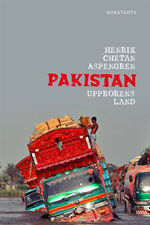 Pakistan – Upprorens land by Dr. Henrik Chetan Aspengren, Dept. of History, Uppsala University, who has lived for a long period in Pakistan. In his Swedish language book, the author mixes
writings on South Asian history with travel writing. Through detailed
descriptions on life in, for example, a Sufi-shrine in Sindh, or a
village of land less peasants in Malakand close to the border between
Pakistan and Afghanistan, Aspengren discusses a wide range of topics:
the Pakistani military’s role in politics; struggles for women’s rights,
democracy, or land rights; religious tolerance and extremism. As such,
the book provides social and historic context to events reported in
the news. Norstedts, April 2011.
Pakistan – Upprorens land by Dr. Henrik Chetan Aspengren, Dept. of History, Uppsala University, who has lived for a long period in Pakistan. In his Swedish language book, the author mixes
writings on South Asian history with travel writing. Through detailed
descriptions on life in, for example, a Sufi-shrine in Sindh, or a
village of land less peasants in Malakand close to the border between
Pakistan and Afghanistan, Aspengren discusses a wide range of topics:
the Pakistani military’s role in politics; struggles for women’s rights,
democracy, or land rights; religious tolerance and extremism. As such,
the book provides social and historic context to events reported in
the news. Norstedts, April 2011. ![]()
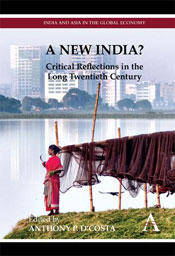 A New India?: Critical Reflections
in the Long Twentieth Century, volume edited by Anthony D'Costa, Professor in Indian Studies and Research Director at the Asia Research Centre, Copenhagen Business School, Denmark. A critical examination of the notion of a ‘new’ India by exposing the many economic, social, and political contradictions that are integral to contemporary India, aimed at scholars and advanced students of contemporary India, comparative politics, and development studies; the intelligent and curious reading public interested in the rise of India. Includes foreword by Deepak Nayyar and chapters by Anthony P. D’Costa on ”New Interpretations of India’s Economic Growth in the Twentieth Century”; Kunal Sen on ”Continuity and Change: Notes on Agriculture in ‘New India’”; and Nitya Rao on ”The ‘New’ Non Residents of India: A Short History of the NRI”. Anthem Press, London, December 2010.
A New India?: Critical Reflections
in the Long Twentieth Century, volume edited by Anthony D'Costa, Professor in Indian Studies and Research Director at the Asia Research Centre, Copenhagen Business School, Denmark. A critical examination of the notion of a ‘new’ India by exposing the many economic, social, and political contradictions that are integral to contemporary India, aimed at scholars and advanced students of contemporary India, comparative politics, and development studies; the intelligent and curious reading public interested in the rise of India. Includes foreword by Deepak Nayyar and chapters by Anthony P. D’Costa on ”New Interpretations of India’s Economic Growth in the Twentieth Century”; Kunal Sen on ”Continuity and Change: Notes on Agriculture in ‘New India’”; and Nitya Rao on ”The ‘New’ Non Residents of India: A Short History of the NRI”. Anthem Press, London, December 2010. ![]()
 Post-War Reconstruction in Sri Lanka: Prospects and Challenges, edited by Dr Dhammika Herath, Dr. Kristine Höglund, Dr. Michael Schulz, and Prof. K.T Silva. Launched in December 2010 by the International Center for Ethnic Studies, it consists of a collection of papers from the first ever conference on “Peace and Development in Sri Lanka” which took place in Kandy, 23-25 August 2009. The purpose of the conference was to bring together and initiate a process of dialogue among local and international researchers and doctoral students, who study peace and development issues in Sri Lanka, and practitioners seeking to address the same issues. The practitioner side was represented by professionals engaged in peace and development through their work in International Non-Governmental Organisations (INGOs), Non-Governmental Organisations (NGOs) and government institutions. The papers in this book reflect the participants’ practical experience and research findings stemming from ongoing research projects.
Post-War Reconstruction in Sri Lanka: Prospects and Challenges, edited by Dr Dhammika Herath, Dr. Kristine Höglund, Dr. Michael Schulz, and Prof. K.T Silva. Launched in December 2010 by the International Center for Ethnic Studies, it consists of a collection of papers from the first ever conference on “Peace and Development in Sri Lanka” which took place in Kandy, 23-25 August 2009. The purpose of the conference was to bring together and initiate a process of dialogue among local and international researchers and doctoral students, who study peace and development issues in Sri Lanka, and practitioners seeking to address the same issues. The practitioner side was represented by professionals engaged in peace and development through their work in International Non-Governmental Organisations (INGOs), Non-Governmental Organisations (NGOs) and government institutions. The papers in this book reflect the participants’ practical experience and research findings stemming from ongoing research projects. ![]()
 Struggle Against the State.
Social Network and Protest Mobilization in India. By Ashok Swain, Professor of Peace and Conflict Research, Uppsala University (and Director, Uppsala Centre for Sustainable Development), demonstrates how displaced people mobilize to protest with the help of their social networks. Studying protests against large industrial and development projects, Swain compares the mobilization process between a traditionally protest rich and a protest poor region in India to explain how social network structures are a key component to understand this variation. He reveals how improved mobilization capability coincides with their evolving social network structure thanks to recent exposure to external actors like religious missionaries and radical left activists.
Struggle Against the State.
Social Network and Protest Mobilization in India. By Ashok Swain, Professor of Peace and Conflict Research, Uppsala University (and Director, Uppsala Centre for Sustainable Development), demonstrates how displaced people mobilize to protest with the help of their social networks. Studying protests against large industrial and development projects, Swain compares the mobilization process between a traditionally protest rich and a protest poor region in India to explain how social network structures are a key component to understand this variation. He reveals how improved mobilization capability coincides with their evolving social network structure thanks to recent exposure to external actors like religious missionaries and radical left activists.
The in-depth examination of the existing literature on social mobilization and extensive fieldwork conducted in India make this book a well-organized and useful resource to analyze protest mobilization in developing regions. Ashgate, Abingdon, UK, August 2010. ![]()
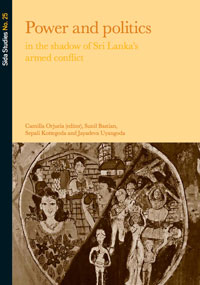 Power and politics in the shadow of Sri Lanka's armed conflict. Report edited by Dr. Camilla Orjuela, School of Global Studies, University of Gothenburg, with chapters written by Dr. Sunil Bastian, Dr. Sepali Kottegoda and Prof. Jayadeva Uyangoda.
It discusses the development in the country after the defeat of the Liberation Tigers of Tamil Eelam (LTTE) in May 2009, that brought Sri Lanka's 26 year long civil war to an end. It also led to a dramatic change in power relations in the island, where politics and everyday life had for decades been dominated by the conflict between the government forces and the Tamil rebels. Throughout Sri Lanka’s modern history, the nationalist projects of the two main conflict parties have dominated the struggles for – and the analysis of – power. This publication highlights other important aspects of power, while also relating them to the armed conflict. The report is published by the Swedish International Development Cooperation Agency (Sida), as Sida Studies No. 25.
Power and politics in the shadow of Sri Lanka's armed conflict. Report edited by Dr. Camilla Orjuela, School of Global Studies, University of Gothenburg, with chapters written by Dr. Sunil Bastian, Dr. Sepali Kottegoda and Prof. Jayadeva Uyangoda.
It discusses the development in the country after the defeat of the Liberation Tigers of Tamil Eelam (LTTE) in May 2009, that brought Sri Lanka's 26 year long civil war to an end. It also led to a dramatic change in power relations in the island, where politics and everyday life had for decades been dominated by the conflict between the government forces and the Tamil rebels. Throughout Sri Lanka’s modern history, the nationalist projects of the two main conflict parties have dominated the struggles for – and the analysis of – power. This publication highlights other important aspects of power, while also relating them to the armed conflict. The report is published by the Swedish International Development Cooperation Agency (Sida), as Sida Studies No. 25.
Link to the full-text report. ![]()
 Curfewed Night: A Frontline Memoir of Life, Love and War in Kashmir, by Basharat Peer. Gives a unique insight into life in a conflict zone, the writer’s own upbringing
and life as a child and youngster. It is also the beautifully written
report of a journalist who returns to the valley and tries to understand
how the conflict has influenced people. This he does by traveling around
and meeting people – people who have been affected by the war in some
particular way, including his own familiy members. Harper Collins, Australia, 2010.
Curfewed Night: A Frontline Memoir of Life, Love and War in Kashmir, by Basharat Peer. Gives a unique insight into life in a conflict zone, the writer’s own upbringing
and life as a child and youngster. It is also the beautifully written
report of a journalist who returns to the valley and tries to understand
how the conflict has influenced people. This he does by traveling around
and meeting people – people who have been affected by the war in some
particular way, including his own familiy members. Harper Collins, Australia, 2010. ![]()
The Partition of India. By Ian Talbot, and Gurharpal Singh. This volume – which comes with an arresting cover illustration showing Indian Border Security Force personnel and Pakistani Rangers at the daily flag-lowering ceremony at the India-Pakistan joint border at Wagah – is an important contribution to our understanding of the multiple meanings of the Partition of India in August 1947. That momentous upheaval not only tore through the social fabric of northern India, uprooting millions amid horrific violence, but left behind important legacies such as the emergence of highly centralized – yet very different – state systems in India and Pakistan and the creation of an “enduring rivalry” between the two nuclear-armed nations. Drawing upon their own major works on pre-Partition Punjab and post-independence India and Pakistan as well as the new Partition historiography that has emerged in recent years, Talbot and Singh set out to explore not just the causes and immediate and long-term consequences of that fateful event but also the kaleidoscopic historical interpretations that 1947 is open to: as the authors note, the Partition is so rich as an ideological resource that in both India and Pakistan “its possibilities are continuously reconstructed at both state and community level” to shore up state legitimacy and community self-identity. Cambridge University Press, New York, 2009 ![]()
 1857: War of Independence or a Clash of Civilizations? British Public Reactions. Salahuddin Malik examines the complicated and divergent reactions of British public opinion (as expressed through the printed word) to the Indian rebellion in 1857. Extensive use of pamphlets, religious tracts, newspapers, periodicals, and sermons (many of which had been previously undiscovered) makes Malik’s work essential to understanding not only the 1857 rebellion, but also British attitudes towards India and imperialism generally. Scholars or students who still generalize about nineteenth-century British thinking on empire will be given pause by the wide range of responses and arguments about the causes of the revolt and what it meant for British India. Oxford University Press, 2008
1857: War of Independence or a Clash of Civilizations? British Public Reactions. Salahuddin Malik examines the complicated and divergent reactions of British public opinion (as expressed through the printed word) to the Indian rebellion in 1857. Extensive use of pamphlets, religious tracts, newspapers, periodicals, and sermons (many of which had been previously undiscovered) makes Malik’s work essential to understanding not only the 1857 rebellion, but also British attitudes towards India and imperialism generally. Scholars or students who still generalize about nineteenth-century British thinking on empire will be given pause by the wide range of responses and arguments about the causes of the revolt and what it meant for British India. Oxford University Press, 2008 ![]()
India and Central Asia: The Mythmaking and
International Relations of a Rising Power. Emilian Kavalski, Lecturer in Politics and International Relations,
School of Humanities,
University of Western Sydney, Australia, writing on India's role in global politics, and how it draws increasing attention from the
international community. Unprecedented economic growth in the recent
past, rising fundamentalism in national politics, and the knife-edge of
nuclear-fuelled tension with an unstable Islamic government in Pakistan,
are all bound up in Indian claims to geopolitical ascendance. At the same
time, Central Asia has re-emerged as a site of international contestation
or a 'new Great Game', with Russia, China and the US vying over security
and energy interests in a politically unstable region. I.B. Tauris, 2010. ![]()
The Gothic, Postcolonialism and Otherness.
Ghosts from Elsewhere.
Tabish Khair, Dept. of Literature, Aarhus University, Denmark, re-examines the role of the colonial/racial Other in mainstream Gothic (colonial) fiction. He goes on to engage with the problem of narrating the 'subaltern' in the post-colonial context. It engages with the problems of representing 'difference' in lucid conceptual terms, with much attention to primary texts, and highlights the strengths and weaknesses of colonial discourses as well as postcolonialist attempts to 'write back.'
Palgrave Macmillan 2009 ![]()
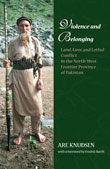 Violence and Belonging.
Land, Love and Lethal Conflict in the North-West Frontier Province of Pakistan.
Are Knudsen, Research Director at the Chr. Michelsen Institute in Bergen, Norway, examines the meanings of lethal conflict in a little-studied tribal society in Pakistan’s unruly North-West Frontier Province (NWFP) and offers a new perspective on its causes. Based on an in-depth study of local conflicts, the book challenges stereotyped images of a region and people miscast as extremist and militant. The book is the first ethnographic study of this region since renowned anthropologist Fredrik Barth’s pioneering study in 1954. NIAS Press 2009.
Violence and Belonging.
Land, Love and Lethal Conflict in the North-West Frontier Province of Pakistan.
Are Knudsen, Research Director at the Chr. Michelsen Institute in Bergen, Norway, examines the meanings of lethal conflict in a little-studied tribal society in Pakistan’s unruly North-West Frontier Province (NWFP) and offers a new perspective on its causes. Based on an in-depth study of local conflicts, the book challenges stereotyped images of a region and people miscast as extremist and militant. The book is the first ethnographic study of this region since renowned anthropologist Fredrik Barth’s pioneering study in 1954. NIAS Press 2009. ![]()
• People of the Jangal. Reformulating Identities and Adaptations in Crisis. Edited by Marine Carrin and Harald Tambs Lyche, including articles by Peter B. Andersen, University of Copenhagen and Gunnel Cederlöf, Uppsala University. Focuses on globalization processes linking centres of power and culture all over the world, surrounded by peripheries, whose integration in the global paradigm is neither an inevitable nor an automatic process. In South Asia, such peripheries seem a long way from the cosmopolitanism of Bombay or Bangalore and the crisis is hardly the same to the ecologist statesman and the herdsman looking for pasture. Societies in the South Asian wilderness – Jangal – are closely tied to the environment but peripheral to the system of power. The peripheral groups studied in this volume are the Santals, the Rona, the Bondo, the Pengs of Orissa, the Jadopatias of Bengal, the Kulava of Kerala and the Todas of Nilgiri among others.
Manohar Books 2008. ![]()
Important new books by Scandinavian scholars on South Asia, December 2007–April 2008: Gunnel Cederlöf, Dept. of History, Uppsala University: Landscapes and the Law: Environmental Politics, Regional Histories, and Contests over Nature (Permanent Black, Delhi). |
• Globalization, Development and The State.
The Performance of India and Brazil since 1990.
Associate Professor Jørgen Dige Pedersen, Dept. of Political Science, University of Aarhus, Denmark presents the story of how India and Brazil have managed the challenges of economic globalization since 1990. Using an innovative combination of theories of developmental states with theories on the changing nature of global capitalism, the analysis presented here explains how India and Brazil have successfully managed those challenges that the opening of their economies has introduced, and their different degrees of success. Palgrave Macmillan 2008. ![]()
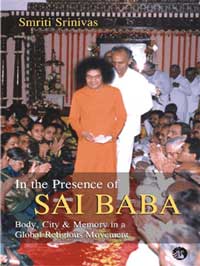 • In the Presence of Sai Baba.
Body, City, and Memory in a Global Religious Movement.
Smriti Srinivas, Associate Professor of Anthropology, University of
California, Davis, on the Sai Baba movement. It is centered on the Indian guru Sathya Sai Baba (b. 1926), today attracting a global following from Japan to South Africa. Regarded as a divine incarnation, Sathya Sai Baba traces his genealogy to Shirdi Sai Baba (d. 1918), a mendicant in colonial India identified with various Sufi and devotional genealogies. The movement, thus, has “roots” in Shirdi Sai Baba but as it globalizes, it has developed conjunctions with other religious traditions, New Religious movements, and New Age ideas. Orient Longman, Hyderabad 2008.
• In the Presence of Sai Baba.
Body, City, and Memory in a Global Religious Movement.
Smriti Srinivas, Associate Professor of Anthropology, University of
California, Davis, on the Sai Baba movement. It is centered on the Indian guru Sathya Sai Baba (b. 1926), today attracting a global following from Japan to South Africa. Regarded as a divine incarnation, Sathya Sai Baba traces his genealogy to Shirdi Sai Baba (d. 1918), a mendicant in colonial India identified with various Sufi and devotional genealogies. The movement, thus, has “roots” in Shirdi Sai Baba but as it globalizes, it has developed conjunctions with other religious traditions, New Religious movements, and New Age ideas. Orient Longman, Hyderabad 2008. ![]()
• A Unique Crime: Understanding Rape in India. In this volume, edited by the Kolkata based journalist Swati Bhattacharjee, articles are put together from various lawyers, doctors, activists, journalists and researchers. The contributors include Parul Sharma, Dept. of Law, Stockholm University. The book aims to develop a discourse on rape that will move on from pre-fabricated ideological frameworks to a multi-dimentional, many-layered dialogue. Gangchil/Kolkata Book Fair 2008. ![]()
• The Republic of Hunger and Other Essays. Utsa Patnaik, Professor of Economics at the Centre for Economic Studies and Planning, Jawaharlal Nehru University, New Delhi, comments on the state of economics as a discipline today, as on the economic policies that are ruining the lives and livelihoods of millions of people in the Third World. The unifying theme of her essays is the impact on the Third World of the new imperialism in the present era, which takes the form of deflationary neo-liberal ‘economic reforms’, a thrust towards free trade and subservient agriculture. She shows how these policies are causing unprecedented rural distress and universal hunger in the developing countries including India. Hers is a voice of sanity, conscience and true scholarship. Three Essays Collective 2007. ![]()
• The Horse, the Wheel, and Language. How Bronze-Age Riders from the Eurasian Steppes Shaped the Modern World. David W. Anthony, professor of anthropology at Hartwick College, UK, solves a puzzle that has vexed scholars for two centuries – the source of the Indo-European languages and English – and recovers a magnificent and influential civilization from the past. Princeton University Press 2007. ![]()
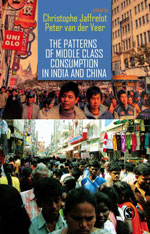 • Patterns of Middle Class Consumption in India and China.
New work by Prof. Christophe Jaffrelot, Center for International Studies and Research, Paris; and Peter van der Veer, University of Utrecht, Netherlands. It is a book about the emerging patterns of consumption among the middle classes of India and China, comparing cultural shifts as a result of liberalization and globalization in these two emerging Asian powers. This volume does not compare India and China to the West, as books on similar subjects have done in the past. Instead they are compared with each other. SAGE Publications 2008
• Patterns of Middle Class Consumption in India and China.
New work by Prof. Christophe Jaffrelot, Center for International Studies and Research, Paris; and Peter van der Veer, University of Utrecht, Netherlands. It is a book about the emerging patterns of consumption among the middle classes of India and China, comparing cultural shifts as a result of liberalization and globalization in these two emerging Asian powers. This volume does not compare India and China to the West, as books on similar subjects have done in the past. Instead they are compared with each other. SAGE Publications 2008 ![]()
• Consumption and the Transformation of Everyday Life
A View from South India.
Associate Professor Harold Wilhite, Centre for Development and Environment (SUM), University of Oslo, contributes to the interpretation of changing consumption in India and to other rapidly developing countries in the South. The author uses an ethnographic approach centred in the Indian state of Kerala to interrogate why and how consumption of household durables, beauty and cleanliness products are growing rapidly. The analysis examines the importance of India's 'opening' to global capitalism after 1991, but also explores the contribution of family, gender, work migration and advertising to changing patterns of consumption. It also shows how changes in the built environment and new technologies regimes associated with energy and water have contributed to changing consumption practices. Palgrave Macmillan August 2008. ![]()
• The City in South Asia, by Prof. James Heitzman, about the macro-region of South Asia – including Bangladesh, India, Nepal, Pakistan, and Sri Lanka – that today supports one of the world’s greatest concentrations of cities, but as Heitzman argues in the first comprehensive treatment of urban South Asia, this has been the case for at least 5,000 years. Routledge 2008. This is a new volume in a Routledge publication series titled ”Asia's Transformations/Asia's Great Cities”. Prof. Heizman has earlier, in 2004, also written a book titled ”Network City. Planning the Information Society in Bangalore”. Another volume in the same series was ”Representing Calcutta.
Modernity, Nationalism and the Colonial Uncanny” by Dr. Swati Chattopadhyay, published in 2005. ![]()
• Red Sun: Travels In Naxalite Country. In this brilliant and disturbing examination of the ‘Other India’, Sudeep Chakravarti combines political history, extensive interviews and individual case histories as he travels to the heart of Maoist zones in the country: Chhattisgarh (home to the controversial state-sponsored Salwa Judum programme to contain Naxalism), Jharkhand, West Bengal, Karnataka and Andhra Pradesh (where a serving chief minister was nearly killed in a landmine explosion triggered by the Naxalites). He meets Maoist leaders and sympathizers, policemen, bureaucrats, politicians, security analysts, development workers, farmers and tribals—people, big and small, who comprise the actors and the audience in this war being fought in jungles and impoverished villages across India. What emerges is a sobering picture of a deeply divided society, and the dangers that lie ahead for India. Penguin/Viking 2007. ![]()
• The Sardar Sarovar Dam Project.
Selected Documents. Dr Philippe Cullet, Senior Lecturer in Law at School of Oriental and African Studies (SOAS), University of London, provides an easily accessible source for all the
main documents relating to this landmark project,one of the most
debated development projects of the past several
decades at both an international level and within
India itself. This
compilation will be a valuable resource for researchers
and policy-makers working in the areas of International
Environmental Law and International Development Law. Ashgate, Aldershot 2007. ![]()
• Promoting Democracy in Fragile States under Conditions of State Fragility,
Issue 1: Afghanistan. Publication including chapters on ”The Dilemma of Reconstruction in Afghanistan:
International Intervention between the State, Civil Society
and Traditional Elites” by Conrad Schetter; on
”Gender in Afghanistan” by Sippi Azerbaijani Moghaddam; and ”Integration of Traditional Structures into the State-building Process:
Lessons from the Tribal Liaison Office in Loya Paktia” by Masood Karokhail and Susanne Schmeidl. Volume edited by the Heinrich Böll Foundation, Berlin 2006. ![]()
• To Make the Deaf Hear:
Ideology and Programme of Bhagat Singh and His Comrades, by the historian S. Irfan Habib, working at the National Institute of Science,
Technology and Development Studies (NISTADS), New Delhi. The book highlights many hitherto neglected aspects
of the evolution of Bhagat Singh as a national hero, and describes the momentous decades of the 1920s
and early 30s when the left-radical agenda came to occupy a huge space
on the Indian Subcontinent. Three Essays Collective, 2007. ![]()
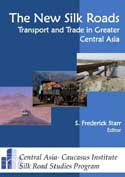 • The New Silk Roads. Transport and Trade in Greater Central Asia. Volume published in 2007, by the Central Asia-Caucasus Institute & Silk Road Studies Program, the joint Transatlantic Research and Policy Center run by
Johns Hopkins University and Uppsala University; edited by S. Frederick Starr. The book includes contributions by eminent scholars from sixteen countries (including Afghanistan, Pakistan and India), reviewing the state of the links of transport and trade that are bringing about this fundamental change on the world’s largest continent. It explores the potential of such interchange for fifteen of the countries most directly affected by it. It identifies some of the many impediments to the full realization of this epochal project. And it suggests a few steps that might be taken to ameliorate or remove these impediments. All articles available as pdf-files.
• The New Silk Roads. Transport and Trade in Greater Central Asia. Volume published in 2007, by the Central Asia-Caucasus Institute & Silk Road Studies Program, the joint Transatlantic Research and Policy Center run by
Johns Hopkins University and Uppsala University; edited by S. Frederick Starr. The book includes contributions by eminent scholars from sixteen countries (including Afghanistan, Pakistan and India), reviewing the state of the links of transport and trade that are bringing about this fundamental change on the world’s largest continent. It explores the potential of such interchange for fifteen of the countries most directly affected by it. It identifies some of the many impediments to the full realization of this epochal project. And it suggests a few steps that might be taken to ameliorate or remove these impediments. All articles available as pdf-files. ![]()
• Military
Inc.: Inside Pakistan's Military Economy. A detailed
exposition by Ayesha Siddiqa, well-known strategic affairs analyst, of
the business and commercial empire run by the armed forces in Pakistan.
Pluto Press, London, 2007.![]()
• The
Clash Within: Democracy, Religious Violence, and India's Future,
by Martha
C. Nussbaum, professor in the philosophy department, law
school, divinity school, and the college at the University of Chicago.
The author examines the Hindu extremism appearing in late February
and March 2002 in the prosperous western Indian state of Gujarat.
In a region internationally famous for its business communities,
Hindu mobs lynched over two thousand Muslims and left more than two
hundred thousand homeless. Nussbaum wishes to introduce her Western
readers to "a
complex and chilling case of religious violence that does not fit some
common stereotypes about the sources o religious violence in today's
world. Read
a review by Pankaj Mishra in New York Review of Books, titled ”Impasse
in India”. Belknap Press/Harvard University
Press 2007. ![]()
• The Republic of Hunger and Other Essays, by Utsa
Patnaik, Professor of Economics at the Centre for Economic Studies and
Planning, Jawaharlal Nehru University, New Delhi. As much a comment
on the state of economics as a discipline today, as on the economic policies
that are ruining the lives and livelihoods of millions of people in the
Third World. The unifying theme of her essays is the impact on the Third
World of the new imperialism in the present era, which takes the form
of deflationary neo-liberal ‘economic
reforms’, a thrust towards free trade
and subservient agriculture. She shows how these policies are causing
unprecedented rural distress and universal hunger in the developing countries
including India. Three Essays Collective 2007. ![]()
 • India After Gandhi: The History of the World's Largest
Democracy, by Ramachandra Guha. So long as the Constitution is not amended
beyond recognition, so long as elections are held regularly and fairly
and the ethos of secularism broadly prevails, so long as citizens can speak
and write in the language of their choosing, so long as there is an integrated
market and a moderately efficient civil service and army, and so long as
Hindi films are watched and their songs sung, India will survive, Guha
concludes his book. Picador
India, 2007.
• India After Gandhi: The History of the World's Largest
Democracy, by Ramachandra Guha. So long as the Constitution is not amended
beyond recognition, so long as elections are held regularly and fairly
and the ethos of secularism broadly prevails, so long as citizens can speak
and write in the language of their choosing, so long as there is an integrated
market and a moderately efficient civil service and army, and so long as
Hindi films are watched and their songs sung, India will survive, Guha
concludes his book. Picador
India, 2007.
![]()
 • Pakistan:
Between Mosque and Military by Husain
Haqqani, leading Pakistani
journalist and former diplomat, who served as a former adviser to three
Pakistani prime ministers.
Presently a visiting
scholar at the Carnegie Endowment for International Peace,
Washington D.C, USA. This book analyzes the origins of the relationships
between Islamist groups and Pakistan’s military, and explores Pakistan’s
quest for identity and security. Tracing how the military has sought
U.S. support by making itself useful for concerns-of-the-moment—while
continuing to strengthen the mosque-military alliance within Pakistan—the
book offers an alternative view of political developments in Pakistan
since independence in 1947. Published by Carnegie
Endowment for International Peace, 2005.
• Pakistan:
Between Mosque and Military by Husain
Haqqani, leading Pakistani
journalist and former diplomat, who served as a former adviser to three
Pakistani prime ministers.
Presently a visiting
scholar at the Carnegie Endowment for International Peace,
Washington D.C, USA. This book analyzes the origins of the relationships
between Islamist groups and Pakistan’s military, and explores Pakistan’s
quest for identity and security. Tracing how the military has sought
U.S. support by making itself useful for concerns-of-the-moment—while
continuing to strengthen the mosque-military alliance within Pakistan—the
book offers an alternative view of political developments in Pakistan
since independence in 1947. Published by Carnegie
Endowment for International Peace, 2005. ![]()
• Untouchability in Rural India. Authored by Ghanshyam Shah, Netherlands Institute for Advanced Study in the Humanities and Social Sciences; Wassenaar Harsh Mander, Centre for Equity Studies, Delhi; Sukhadeo Thorat, University Grants Commission, Delhi; Satish Deshpande, Institute of Economic Growth, Delhi; and Amita Baviskar, Institute for Economic Growth, Delhi. The book presents systematic evidence of the incidence and extent of the practice of untouchability in contemporary India. It is based on the results of a very large survey covering 560 villages in 11 states, which found that untouchability continues to be widely prevalent and is practiced in one form or another in almost 80 percent of the villages. Sage Publications 2006. The results from this book were highlighhted in the resolution on the human rights situation of Dalits in India, adopted by the European Parliament on 1 February 2007.
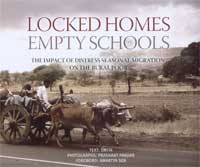 • Locked
Homes, Empty Schools: The Impact of Distress Seasonal Migration on
the Rural Poor, by Smita, who used
to work for the Sida supported Lok Jumbish project in Rajasthan.
Photographs by Prashant
Panjiar, and a foreward by Amartya
Sen. Every year millions of impoverished
families living in the rainfed parts of India leave their homes in
search of work. Forced to migrate due to a livelihoods collapse in
the villages, these distress seasonal migrants shut up their spartan
homes, take a few meager belongings and move, often across long distances.
This study, commissioned by the American India Foundation, draws
on the work of four NGOs in different parts of India, and in different
sectors: sugarcane harvesting in Maharashtra, salt pan, roof tile
and charcoal making in Gujarat, and brick kiln migrations from Orissa
to Andhra Pradesh. Book brought out by the American India Foundation
(AIF) and publishing house Zubaan 2006.
• Locked
Homes, Empty Schools: The Impact of Distress Seasonal Migration on
the Rural Poor, by Smita, who used
to work for the Sida supported Lok Jumbish project in Rajasthan.
Photographs by Prashant
Panjiar, and a foreward by Amartya
Sen. Every year millions of impoverished
families living in the rainfed parts of India leave their homes in
search of work. Forced to migrate due to a livelihoods collapse in
the villages, these distress seasonal migrants shut up their spartan
homes, take a few meager belongings and move, often across long distances.
This study, commissioned by the American India Foundation, draws
on the work of four NGOs in different parts of India, and in different
sectors: sugarcane harvesting in Maharashtra, salt pan, roof tile
and charcoal making in Gujarat, and brick kiln migrations from Orissa
to Andhra Pradesh. Book brought out by the American India Foundation
(AIF) and publishing house Zubaan 2006. ![]()
• Lesser-Known
Languages of South Asia Status and Policies, Case Studies and Applications
of Information Technology, efited by Anju
Saxena and
Lars Borin. The volume brings together areas of
research on a large number of smaller languages in South Asia. It
provides basic knowledge about the problems involved and some directions
from which solutions could be forthcoming,
for helping to shape the linguistic future of South Asia. Mouton
de Gruyter, Berlin 2006. ![]()
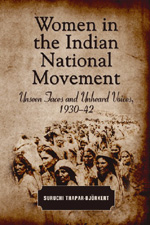
• Unseen
Faces and Unheard Voices, Women in the Indian Nationalist Movement,
1930-1942 by Suruchi Thapar-Björkert,
University of Bristol, UK. It focuses on the nationalist participation
of ordinary middle-class women in India’s freedom movement, especially
in the United Provinces (modern Uttar Pradesh). In particular,
it looks at a specific development during this period, the politicisation
of the domestic sphere. Those purdah bound women who led restricted
lives within the domestic sphere also contributed to the movement, thus
making confining social practices enabling ones. Sage
Publications 2006. ![]()
• Welfare
State, Right to Life and Capital Punishment in India. Parul
Sharma analyses
the socio-legal framework in India, where a welfare state, right to life
and the capital punishment operate side by side. The inter linkages and
contradictions dealt with are relevant to societies with complicated
and vast social structures such as India’s. Sampark
Publications, Kolkata/New Delhi, 2005 ![]()
•
Representing India: Ethnic Diversity and the Governance of Public Institutions by Niraja Gopal Jayal,
Professor at the Centre for the Study of Law and Governance, Jawaharlal
Nehru University, India. Deals with India’s
complex ethnic cleavages, that seem to defy classification as a single
ethnic structure. The country is home to more than 1,600 language groups
and six major religions. Followers of the Hindu religion are further
divided by a hierarchical caste system. In addition, about 10 per cent
of the population has been characterized as tribal. Despite this complexity,
India is an established democracy and has registered high growth rates
in recent years. These outcomes question notions that link ethnic diversity
with authoritarian rule and low growth. Palgrave
Macmillan Publishers 2006. ![]()
• Opium Poppy Eradication: How to raise risk
when there is nothing to lose? David
Mansfield and Adam Pain on the fact that
opium poppy cultivation in Afghanistan is likely to rise during 2006.
The increase will not be uniform across the country, however, but specific
to certain areas. In particular, if predictions are correct, Helmand
province in the southern region is likely to see significant expansion
in the amount of land allocated to opium poppy, possibly exceeding the
previous peak of 45,000 hectares (ha) in 1999. This increase is likely
to more than compensate for any reductions in cultivation in other provinces.
Briefing paper from Afghanistan Research and Evaluation
Unit (AREU), August 2006 ![]()
 •
State of the World’s Cities Report 2006/7, and Water
and Sanitation in the World´s Cities 2006: Meeting Developing Goals
in Small Urban Centres.
Two new volumes from the United Nations Human Settlements
Programme (UN-HABITAT),
the world’s leading authority on
urban development, unpicks the issues and proposes practical policy reforms.
Guided in focus by the UN Millennium Development Goals, the report considers
the wide range of issues that affect the lives of (mainly poor) urban
dwellers: water and sanitation, shelter, overcrowding, malnutrition,
HIV/AIDS, education, employment, and more. It
claims that during the next 12 months, the world will reach a tipping
point and for the first time in history the world’s population
will be more urban than rural. Also discussing epidemic disease, overcrowding,
malnutrition, crime – how can the growth of these and other problems
be avoided in an urbanized world?
•
State of the World’s Cities Report 2006/7, and Water
and Sanitation in the World´s Cities 2006: Meeting Developing Goals
in Small Urban Centres.
Two new volumes from the United Nations Human Settlements
Programme (UN-HABITAT),
the world’s leading authority on
urban development, unpicks the issues and proposes practical policy reforms.
Guided in focus by the UN Millennium Development Goals, the report considers
the wide range of issues that affect the lives of (mainly poor) urban
dwellers: water and sanitation, shelter, overcrowding, malnutrition,
HIV/AIDS, education, employment, and more. It
claims that during the next 12 months, the world will reach a tipping
point and for the first time in history the world’s population
will be more urban than rural. Also discussing epidemic disease, overcrowding,
malnutrition, crime – how can the growth of these and other problems
be avoided in an urbanized world? ![]()
• The Global Deserts Outlook. The first thematic assessment
report in the Global Environment Outlook (GEO) series of the United
Nations Environment Programme (UNEP), and a UNEP contribution to
the International Year of Deserts and Desertification in 2006. The report
presents a panorama of the environmental
status of the world's deserts: their location and extent, uniqueness
and vulnerability, biodiversity and natural resources. The report provides
a balanced picture of deserts as ecosystems which form a special part
of the world's natural and cultural heritage, and not simply as land
that is the end result of the process of desertification. Few places
on earth contain a richer collection of natural adaptations to the environment. ![]()
• Untouchability
in Rural India authored
by Ghanshyam Shah, Netherlands Institute for Advanced
Study in the Humanities and Social Sciences, Wassenaar;
Harsh Mander, Centre
for Equity Studies, Delhi; Sukhadeo Thorat, University
Grants Commission, Delhi; Satish Deshpande, Institute
of Economic Growth, Delhi, and Amita Baviskar, Associate
Professor, Institute for Economic Growth, Delhi. A
presention of systematic evidence of the incidence and extent of
the practice of untouchability in contemporary India. It is based on
the results of a very large survey covering 560 villages in 11 states,
which found that untouchability continues to be widely prevalent and
is practiced in one form or another in almost 80 percent of the villages.
Sage Publications, July 2006. ![]()
•
Role of Minorities in Nation Building with Focus on Karachi. Ahmed
Salim highlights the important role played by minorities in nation building
in Pakistan in the wake
of Partition, covering the period from the early 18th century to present
times. Church World
Service Pakistan/Afghanistan 2006. Excerpt from the Dawn 13 August 2006. ![]()
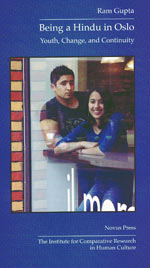 •
Being a Hindu in Oslo: Youth, Change, and Continuity,
by
Ram Gupta. Based on fieldwork interviews, the
book discusses how the Norwegian majority culture influences thinking
about Hinduism and religion in general among among second-generation
Indian Hindus in Oslo. It offers a great deal of factual information
on Hindus in Norway, which incidentally, has a larger population of
South Asian immigrants than all of the Nordic countries combined. The
book is a revised version of the author's Cand. Philol. thesis in History
of Religion, submitted at the University of Oslo in 2002. Novus
forlag,
Oslo 2006.
•
Being a Hindu in Oslo: Youth, Change, and Continuity,
by
Ram Gupta. Based on fieldwork interviews, the
book discusses how the Norwegian majority culture influences thinking
about Hinduism and religion in general among among second-generation
Indian Hindus in Oslo. It offers a great deal of factual information
on Hindus in Norway, which incidentally, has a larger population of
South Asian immigrants than all of the Nordic countries combined. The
book is a revised version of the author's Cand. Philol. thesis in History
of Religion, submitted at the University of Oslo in 2002. Novus
forlag,
Oslo 2006. ![]()
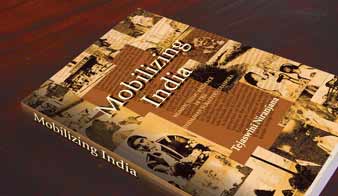 • Mobilizing
India. Women in Trinidad Music. Comparative research
study on women, music and migration
between India and the Caribbean, by Tejaswini
Niranjana,
Director of the Centre for the Study of Culture and Society, Bangalore.
She investigates the subtle changes occurring in the composition of "Indianness" in
transnational spaces. Books
Fulfillment,
Duke University Press,
Durham, NC,
USA, 2006.
• Mobilizing
India. Women in Trinidad Music. Comparative research
study on women, music and migration
between India and the Caribbean, by Tejaswini
Niranjana,
Director of the Centre for the Study of Culture and Society, Bangalore.
She investigates the subtle changes occurring in the composition of "Indianness" in
transnational spaces. Books
Fulfillment,
Duke University Press,
Durham, NC,
USA, 2006. ![]()
• Erotic
Literature of Ancient India: Kama Sutra, Koka Shastra, Gita Govindam,
Ananga Ranga, by Indian author and journalist
Sandhya Mulchandani, translator of medieval Kama Shastra
Sanskrit manuscripts into English, and working on a dissertation on
ancient concepts of ethics and governance and their relevance and application
in modern societies.
Roli Books, New Delhi 2006. ![]()
•
Opium City. The Making of Early Victorian Bombay.
Amar Farooqui on the fundamentals of how and why India was
colonised by the East India Company, in a time when it sometimes
appears, from the nature of current historical debates, as if the
British empire in India was purely an orientalising mission whose
discourses generated a politics of identity. Farooqui connects back
to the earliest nationalists who decried the drain of wealth from
India, who lamented India’s deindustrialisation and the economic
exploitation of our people by foreign occupiers. Three
Essays Collective ,
New Delhi, 2005. ![]()
•
The Bhopal Saga: Causes and Consequences of the World's Largest Industrial
Disaster. By Ingrid Eckerman, on how
after 20 years, victims, health care workers, and governments are still
trying to comprehend what has been called the world's worst industrial
accident. The Bhopal Saga is an attempt to bring order from the chaos
of events before, during, and after the methyl isocyanate (MIC) release.
Not a scientific analysis, the book summarizes events leading up to
the accident of December 1984 and the relief work in the ensuing two
decades. Universities Press, Hyderabad, India, 2005. ![]()
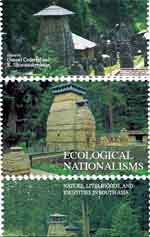 •
Ecological Nationalisms. Nature, Livelihoods, and Identities in South
Asia. Edited by Gunnel Cederlöf, associate
professor of history, Uppsala University, and K. Sivaramakrishnan,
professor of anthropology and international studies and director of the
South Asia Center, Jackson School of International Studies, at the University
of Washington. Volume exploring how questions of national identity become
entangled with environmental concerns in Bangladesh, Nepal, Pakistan,
and India. The essays provide insight into the motivations of colonial
and national governments in controlling or managing nature, and bring
into fresh perspective the different kinds of regional political conflicts
that invoke nationalist sentiment through claims on nature. Permanent
Black, Delhi, 2005 & University of Washington Press,
Seattle, USA, 2006.
•
Ecological Nationalisms. Nature, Livelihoods, and Identities in South
Asia. Edited by Gunnel Cederlöf, associate
professor of history, Uppsala University, and K. Sivaramakrishnan,
professor of anthropology and international studies and director of the
South Asia Center, Jackson School of International Studies, at the University
of Washington. Volume exploring how questions of national identity become
entangled with environmental concerns in Bangladesh, Nepal, Pakistan,
and India. The essays provide insight into the motivations of colonial
and national governments in controlling or managing nature, and bring
into fresh perspective the different kinds of regional political conflicts
that invoke nationalist sentiment through claims on nature. Permanent
Black, Delhi, 2005 & University of Washington Press,
Seattle, USA, 2006. ![]()
•
Rethinking Indian Political Institutions, volume edited by Crispin
Bates, Director of studies in the Department of History at the
University of Edinburgh, and Subho Basu, Teaching Fellow
in the Department of History as SOAS, University of London. A book of
interest to undergraduates enrolled on contemporary Asian History and
politics courses, as well as to those interested in more general theories
of the state and civil society. The work will address questions arising
from globalization, liberalization, and decentralization that concern
political scientists and sociologists as well as contemporary historians.
Includes an article on ”Ideological Integration in Post-Colonial
(South) India: Aspects of a Political Language” by Pamela Price,
University of Oslo. Anthem Press 2005. ![]()
 •
Schooled for the Future? Educational Policy and Everyday Life among Urban
Squatters in Nepal. By Karen Valentin, Assistant
Professor at the Institute of Educational Anthropology, Danish University
of Education, Copenhagen. It offers an ethnographically rich account about
squatter families in Kathmandu and their struggles to improve their living
conditions and create a better future through education. Examining how
people – children and adults – experience and respond to policy
initiatives aimed at improving their life the book discusses the paradoxes
inherent in modern schooling. Information Age Publishing Inc.,
Greenwich, CT, USA.
•
Schooled for the Future? Educational Policy and Everyday Life among Urban
Squatters in Nepal. By Karen Valentin, Assistant
Professor at the Institute of Educational Anthropology, Danish University
of Education, Copenhagen. It offers an ethnographically rich account about
squatter families in Kathmandu and their struggles to improve their living
conditions and create a better future through education. Examining how
people – children and adults – experience and respond to policy
initiatives aimed at improving their life the book discusses the paradoxes
inherent in modern schooling. Information Age Publishing Inc.,
Greenwich, CT, USA. ![]()
•
Indigeneity in India, edited by Bengt G. Karlsson,
Dept. of Cultural Anthropology, Uppsala University, and Tanka
B. Subba, Professor of Social Anthropology, North-Eastern Hill
University, India. A volume dealing with the issue of who and what are
‘indigenous peoples’? The question has become highly contentious
in India today, where eighty million peoples belonging to the state category
of ‘scheduled tribes’ are attempting to gain international
recognition as indigenous people, as part of their struggle for recognition
and rights in land and resources. Dr. Pernille Gooch, Dept. of Human Ecology,
Lund University, is also represented in the book, with an article on the
Van Gujjars. Keganpaul, London, 2005. ![]()
•
Violent Belonging: Land, Love and Lethal Conflict in a Kohistani Community,
Pakistan, by Norwegian anthropologist Are Knudsen.
Based on research in a tribal Muslim community in Northern Pakistan, the
book argues that lethal conflict and frequent homicide cannot be understood
simply as expressions of personal and group honour, but must be framed
within local notions of attachment to the locality and kin-group. NIAS
Press 2005. ![]()
 •
Dispatches from the People's War in Nepal, by Li
Onesto, the first foreign journalist to travel deep into the
guerrilla zones, depicting the Maoist revolution has been raging in Nepal
since 1996. The book provides an invaluable analysis of the social and
economic conditions that have fuelled the revolution and profiles some
of the key people involved. Pluto Press & Insight Press
2004.
•
Dispatches from the People's War in Nepal, by Li
Onesto, the first foreign journalist to travel deep into the
guerrilla zones, depicting the Maoist revolution has been raging in Nepal
since 1996. The book provides an invaluable analysis of the social and
economic conditions that have fuelled the revolution and profiles some
of the key people involved. Pluto Press & Insight Press
2004. ![]()
•
Dalits in Dravidian Land. Frontline reports on anti-dalit violence in
Tamil Nadu (1995-2004). S. Viswanathan reports
on the spurt in violence against dalits since the 1990s, perpetrated largely
by the 'backward' castes, who claim victimhood under brahmins but also
turn oppressors of dalits. Tamil Nadu, home to the nonbrahmin movement,
has been projected by the political class, social scientists and policy-makers
as fertile soil for social justice. However, the Dravidian movement's
empowerment agenda left the dalits – 19 percent of the population
– almost untouched. Navayana Publishing 2005. ![]()
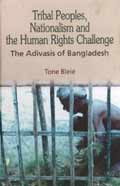 •
Tribal peoples, nationalism and the human rights challenge. The Adivasis
of Bangladesh, by Tone Bleie, Chr. Michelsen
Institute, CMI, Bergen, Norway. The book unravels how the Adivasis have
not been given their due recognition inspite of their history as Bengal's
earliest inhabitants and their prominent role in mass rebellions leading
up to the nationalist movement. University Press Limited, Dhaka,
2005.
•
Tribal peoples, nationalism and the human rights challenge. The Adivasis
of Bangladesh, by Tone Bleie, Chr. Michelsen
Institute, CMI, Bergen, Norway. The book unravels how the Adivasis have
not been given their due recognition inspite of their history as Bengal's
earliest inhabitants and their prominent role in mass rebellions leading
up to the nationalist movement. University Press Limited, Dhaka,
2005.![]()
•
Climate Change and Water Resources in South Asia. Edited
by M. Monirul Qader Mirza, Adaptation and Impacts Research
Group (AIRG), Environment Canada, and Dr. Q.K. Ahmad,
Chairman, Bangladesh Unnayan Parishad. A book addressing the most pressing
water resources issues in South Asia, particularly in relation to climate
change and variability. This is a region with abundant water during the
monsoon when floods occur, often very devastating and with droughts and
scarcity of water during the dry period. Inevitably there are wide seasonal
and spatial variations. Taylor & Francis, U.K, 2005. ![]()
•
Blended Boundaries. Caste, Class and Shifting Faces of Hinduness in a
North Indian City. Dr. Kathinka Frøystad,
Dept. of Social Anthropology, University of Oslo, Norway, provides an
ethnographic account of the shifts in political preferences of upper caste
Hindus in a North Indian city, exploring how a community consisting predominantly
of Hindu nationalists relates to the Muslim an Dalit communities and seeks
to explain their ever shifitng social and political perceptions. Oxford
University Press 2005. ![]()
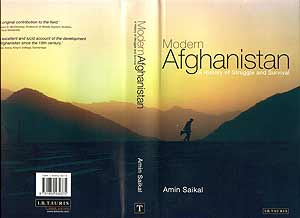 •
Modern Afghanistan. A History of Struggle and Survival. Amin
Saikal, Director of the Center for Middle Eastern and Central
Asian Studies, and Professor of Political Science at Australian National
University, provides a new approach to understanding a region that has
been pushed to the forefront of world politics by the Soviet invasion
of 1979, followed by murderous civil war in the 1980s, and then the establishment
of the Taliban regime that resulted in American intervention following
the catastrophe of 9/11. Saikal seeks to answer why Afghanistan's course
of development has been so turbulent and why it remains so vulnerable
to domestic instability, foreign intervention and ideological extremism.
He argues that this was largely due to rivalries stemming from a series
of dynastic alliances within the successive royal families from the end
of the eighteenth century to the pro-Communist coup of April 1978. I.B.
Tauris November 2004.
•
Modern Afghanistan. A History of Struggle and Survival. Amin
Saikal, Director of the Center for Middle Eastern and Central
Asian Studies, and Professor of Political Science at Australian National
University, provides a new approach to understanding a region that has
been pushed to the forefront of world politics by the Soviet invasion
of 1979, followed by murderous civil war in the 1980s, and then the establishment
of the Taliban regime that resulted in American intervention following
the catastrophe of 9/11. Saikal seeks to answer why Afghanistan's course
of development has been so turbulent and why it remains so vulnerable
to domestic instability, foreign intervention and ideological extremism.
He argues that this was largely due to rivalries stemming from a series
of dynastic alliances within the successive royal families from the end
of the eighteenth century to the pro-Communist coup of April 1978. I.B.
Tauris November 2004.
• Politics of Identity. Ethnic Nationalism and the State in Pakistan, by Adeel Khan, University of New England, Armidale, Australia. The book explores the relationship between ethnicity, nationalism and the modern state, examining the pre-colonial state system in India; the colonial state system and the changes that it effected until partition and the independence of India. The author takes four ethnic movements – Pakhtun, Baloch, Sindhi and Mohajr – as case studies and finally sums us the contemporary scenario of ethnic conflicts in Pakistan. Sage Publications 2004.
 •
The Idea of Pakistan. Stephen Philip Cohen,
senior fellow in the Foreign Policy Studies program at the Brookings Institution,
USA, on how Pakistan in recent years has emerged as a strategic player
on the world stage—both as a potential rogue state armed with nuclear
weapons and as an American ally in the war against terrorism. He offers
a panoramic portrait of the complex country – from its origins as
a homeland for Indian Muslims to a military-dominated state that has experienced
uneven economic growth, political chaos, sectarian violence, and several
nuclear crises with its much larger neighbor, India. Brookings Institution
Press 2004.
•
The Idea of Pakistan. Stephen Philip Cohen,
senior fellow in the Foreign Policy Studies program at the Brookings Institution,
USA, on how Pakistan in recent years has emerged as a strategic player
on the world stage—both as a potential rogue state armed with nuclear
weapons and as an American ally in the war against terrorism. He offers
a panoramic portrait of the complex country – from its origins as
a homeland for Indian Muslims to a military-dominated state that has experienced
uneven economic growth, political chaos, sectarian violence, and several
nuclear crises with its much larger neighbor, India. Brookings Institution
Press 2004.
•
Himalayan 'People's War'. Nepal's Maoist Rebellion, edited
by Michael Hutt, Reader in Nepali at School of Oriental
and Asian Studies, London. The eruption of a violent Maoist insurgency
in Nepal in the late 1990s was met with bewilderment even among many of
those who claimed to know the country well. Such a development possesses
its own historical depth and socio-cultural background. This book provides
much of that background and description of the ongoing struggle.
Hurst & Co 2004. Read
a review article called ”Statskupp i paradiset” by Rolf
Jonsson, researcher at Stockholm University, in Dagens Nyheter
11 February 2005 (in Swedish)![]()
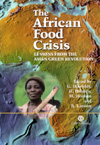 •
The African Food Crisis: Lessons from the Asian Green Revolution.
Edited by Göran Djurfeldt and Rolf Larsson,
both from Dept. of Sociology, Lund University; Magnus Jirström,
Dept. of Social and Economic Geography, Lund University; and Hans
Holmén, Dept. of Geography, Linköping University.
A result of a 3-year project coordinated by a group of Swedish researchers
and with collaborating scholars from all over the World. In India they
were inspired by interviews with M.S. Swaminathan and G.S. Bhalla, and
in Bangladesh by Mahabub Hossain and his network. CAB Publishing,
London, 2005.
•
The African Food Crisis: Lessons from the Asian Green Revolution.
Edited by Göran Djurfeldt and Rolf Larsson,
both from Dept. of Sociology, Lund University; Magnus Jirström,
Dept. of Social and Economic Geography, Lund University; and Hans
Holmén, Dept. of Geography, Linköping University.
A result of a 3-year project coordinated by a group of Swedish researchers
and with collaborating scholars from all over the World. In India they
were inspired by interviews with M.S. Swaminathan and G.S. Bhalla, and
in Bangladesh by Mahabub Hossain and his network. CAB Publishing,
London, 2005.![]()
• Small Hands in South Asia: Child Labour in Perspective, edited by G.K. Lieten, Ravi Srivastava and Sukhadeo Thorat. The book is an outcome of the International conference on Child Labour in South Asia, funded by the Indo-Dutch Programme for Alternatives in Development (IDPAD) and the Indian Council of Social Science Research (ICSSR), held in Delhi in 2001. Consists of 13 essays by academicians, policy makers and activists. Manohar Publishers 2004.
• Indo-Aryan Controversy. Evidence and Inference in Indian History, edited by Laurie L. Patton and Edwin Bryant. The major questions considered in this book are whether the Indo-Aryans were outsiders or insiders? Did they migrate into India from Central Asia, and if not, where did they originate? Even more crucially, what is at stake in these accounts of ancient history? RoutledgeCurzon 2004
• Unfamiliar Relations. Family and History in South Asia, by Indrani Chatterjee, associate professor of history at Rutgers University, USA. Contributions also made by William Dalrymple, Pamela G. Price, and others. ”Unfamiliar Relations” restores the family and its many forms and meanings to a central place in the history of South Asia between the seventeenth and nineteenth centuries. Topics include a British colonial officer who married a Mughal noblewoman and converted to Islam around the turn of the nineteenth century, the role gossip and taboo play in the formation of Indian family history, and an analysis of social relations in the penal colony on the Andaman Islands. Rutgers University Press 2004.
• Pakistan: In the Shadow of Jihad and Afghanistan, by Mary Anne Weaver. A book comprising seven chapters covering the entire gamut of contemporary issues including the rising trends of ‘Jihad’ and extremism, based on the author’s extensive personal interviews with important military, tribal, religious and political leaders in Pakistan. Farrar, Straus and Giroux, New York 2003
• Conflictual Peacebuilding: Afghanistan two years after Bonn. Report by Astrid Suhrke, Kristian Berg Harpviken and Arne Strand. Prepared for The Norwegian Ministry of Foreign Affairs by the International Peace Research Institute, PRIO, Oslo, and Chr. Michelsen Institute, Bergen, Norway, 2004. Development Studies and Human RightsCMI, 2004.
• 'Between Heaven and Hell'. Travels Through South Asia. Soon after the nuclear tests conducted by India and Pakistan in 1998, the celebrated explorer, author and filmmaker Akhil Bakshi led an 18,000 km motoring expedition – Hands Across The Borders – to promote peace and development in South Asia. The journey, with activists from the region, was envisaged as a massive contact programme through the interiors of Sri Lanka, India, Bangladesh, Bhutan, Nepal, and Pakistan. Between Heaven and Hell is an eminently readable account of that momentous journey. Odyssey Books, New Delhi, India
• Sustainable Management of Wetlands: Biodiversity and beyond. A comprehensive and multidisciplinary study of wetlands in India, by Jyoti Parikh, and Hemant Datye, uniting the natural science perspective with strong social concerns and economic and other approaches in order to design a practical national wetlands conservation strategy and action plan. Integrated Research and Action for Development (IRADe), New Delhi, India, 2003.
• Political Islam in South Asia. Report by social anthropologist Are John Knudsen, senior researcher at Chr. Michelsen Institute, Bergen, Norway, analysing the growth of political Islam in South Asia (Pakistan, Afghanistan and India's Jammu and Kashmir Province). CMI Report R 2002:14
• Conflict, Human Rights & Peace: Challenges Before Nepal. Edited by Dr Bipin Adhikari, the book includes a compilation of articles and papers presented in a lecture series organized by the National Human Rights Commission in the year 2003. It includes 13 scholarly papers dealing with the present situation of conflict between the Government and the Maoists from a human rights perspective, prominent contributors to the book include the Assistant Secretary General to the United Nations Kul Chandra Gautam, famous international peacemaker and scholar Johan Galtung, and Henning Karcher, the former Resident Representative of United Nations Development Program (UNDP) in Nepal.
• South Asians in the Diaspora. Histories and Religious Traditions. Edited by Knut A. Jacobsen and P. Pratap Kumar. The diversity of religious life in South Asia is remarkable and much of this diversity is replicated in the diaspora communities around the world. The case studies in this book explore and analyse the social, religious and cultural reality of people in the diaspora belonging to Jainism, Buddhism, Hinduism, Christianity, Islam, Sikhism and Zoroastrianism and originating from four of the South Asian nation states (India, Pakistan, Bangladesh and Sri Lanka). Numen Book Series 2003.
• Aligarh’s First Generation – Muslim Solidarity in British India. David Lelyveld explores the nature of Muslim cultural identity in India in the nineteenth century, and the changes it underwent, in the context of colonial rule. The author examines the history of the Muhammadan Anglo-Oriental College (Aligarh Muslim University) during the first twenty-five years of its existence, the period when the first generation of Muslims educated in English graduated from the college. Oxford University Press 2003.
• Modernization and Effeminization in India. Kerala Cashew Workers Since 1930. Anna Lindberg’s praised doctoral thesis (see http://www.sasnet.lu.se/histlund.html) now available as a monograph published by NIAS Press 2003.
• Calcutta: A cultural and literary companion. Krishna Dutta explores the multiple paradoxes of Kolkata, giving personal insight into the city’s unique history and modern identity as reflected in its architecture, literature, cinema and music. Foreword by Anita Desai. Dutta effectively counters the vulgar image on the ”hellish city” put forward by Claude Levi-Strauss, Loiuse Malle and Günter Grass. Interlink Books 2003.
• Fruits of Worship: Practical Religion in Bengal. Essays by Ralph W Nicholas (Professor Emeritus of Anthropology and of Social Sciences, University of Chicago) on the religious life of ordinary people in rural Bengal, including the Bengali attachment to Goddesses. Chronicle Books, New Delhi (imprint of DC Publishers) 2003.
• The Yogasastra of Hemacandra. A Twelfth Century Handbook on Svetambara Jainism. Edited and translated by Olle Qvarnström, Asst. Professor, Dept of History of Religions, with emphasis on Indic Religions; Lund University. (Harvard University Press 2002). Written in the twelfth century A.D. by the polymath Hemacandra, it was instrumental in the survival and growth of Jainism in India as well as in the spreading of Sanskrit culture within Jaina circles. The present translation is the first of its kind in a Western language.
• Christians and Missionaries in India: Cross-Cultural Communication since 1500. New volume in the Series: Studies in the History of Christian Missions, edited by Robert Eric Frykenberg. The book challenges the long-held assumption that Christianity in India is nothing but a colonial or Western imposition. Leading experts, including Scandinavian researchers Gunnel Cederlöf and Peter B Andersen, here chronicle the histories and cultures of India's many Christian communities and show that local Indian leaders were the real agents of religious change in the subcontinent. Eerdmans/Curzon Press 2003.
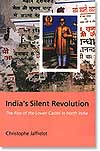 •
India's Silent Revolution – The Rise of the Lower Castes.
Christophe Jaffrelot, deputy director of Centre d'Etudes
et de Recherches Internationales, CERI, Paris. Since the 1960s a new assertiveness
has characterized India's formerly silent majority, the lower castes that
comprise more than two-thirds of the population. Today India's most populous
state, Uttar Pradesh, is controlled by lower-caste politicians, as is
Bihar, and lower-caste representation in national politics is growing
inexorably. Jaffrelot argues that this trend constitutes a genuine ”democratization”
of India and that the social and economic effects of this ”silent
revolution” are bound to multiply in the years to come. Hurst
& Co 2003.
•
India's Silent Revolution – The Rise of the Lower Castes.
Christophe Jaffrelot, deputy director of Centre d'Etudes
et de Recherches Internationales, CERI, Paris. Since the 1960s a new assertiveness
has characterized India's formerly silent majority, the lower castes that
comprise more than two-thirds of the population. Today India's most populous
state, Uttar Pradesh, is controlled by lower-caste politicians, as is
Bihar, and lower-caste representation in national politics is growing
inexorably. Jaffrelot argues that this trend constitutes a genuine ”democratization”
of India and that the social and economic effects of this ”silent
revolution” are bound to multiply in the years to come. Hurst
& Co 2003.
• Poetics of Village Politics. The Making of West Bengal's Rural Communism, by Arild Engelsen Ruud, Center for Development and the Environment (SUM), Oslo, Norway. This study deals with local-level politics in two villages in Burdwan district of West Bengal, India. It deals with the emergence of left politics in West Bengal in the late 60s and analyzes its electoral success for nearly three decades in the state. Oxford University Press 2003.
• Fruits of Worship: Practical Religion in Bengal, by Ralph W. Nicholas, Professor Em. of Anthropology, University of Chicago, and President of the American Institute of Indian Studies. Chronicle Books, New Delhi, 2003
• Unhinging Hinglish: The Languages and Politics of Fiction in English from the Indian Subcontinent. Papers presented at a conference on ”Fiction in English from the Indian Subcontinent and South Asian Diaspora”, arranged by the Universities of Aarhus and Copenhagen, Denmark. Edited by Nanette Hale & Tabish Khair. Museum Tusculanum Press, University of Copenhagen 2001.
• Stigma, status och strategier. Genusperspektiv i religionsvetenskap. Anthology (in Swedish) on Gender perspectives within Science of Religion, edited by Catharina Raudvere, with articles on Hinduism by Sidsel Hansson and Lisbeth Andersson, History of Religions, Dept of Theology, Lund University. Studentlitteratur 2003.
• Jihad – The Trail of Political Islam, by Prof. Gilles Kepel, Institute for Political Studies, Paris, France, on the growth of Islamist political movements during the the last part of the 20th Century. I B Tauris 2003.
• ”Can you stop the birds singing?” – The censorship of music in Afghanistan, by Dr. John Baily, reader in Ethnomusicology, Goldsmiths College, London, on the music under Taliban regime. Published by Freemuse, World Forum on Music & Censorship.
• India, Development and Participation, by Jean Dreze, Honorary Professor, Delhi School of Economics, and Amartya Sen, Master, Trinity College, Cambridge University. Oxford University Press 2002.
• Sri Lankan Ethnic Crisis: Towards a Resolution, by R B Herath, Director, South Asian Network for Secularism and Democracy (SANSAD), Canada. Own publication 2002
• Bringing the Food Economy Home – Local Alternatives to Global Agribusiness. Helena Norberg-Hodge (founder and director of the International Society for Ecology and Culture, ISEC), Todd Merrifield & Steven Gorelick. Zed Books 2002
• Gender and Slum Culture in Urban Asia, by Susanne Thorbek, Senior Lecturer, Institute for Development and Planning, Aalborg University, Denmark. Danish PhD network on Development and International Relations, Occasional Paper Series 2002. Compares the social and cultural life prevailing in two Asian slums – one on the outskirts of Colombo, Sri Lanka, the other in Bangkok, Thailand.
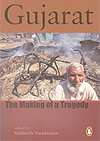 •
Gujarat. The Making of a Tragedy. Edited by Siddharth Varadaraja.
Penguin Books India 2002. This book is intended to be a permanent
public archive of the tragedy that is Gujarat. Drawing upon eyewitness
reports from the English, Hindi and regional media, citizens’ and
official fact-finding commissions – and articles by leading public
figures and intellectuals – it provides a chilling account of how
and why the state was allowed to burn (Press release).
•
Gujarat. The Making of a Tragedy. Edited by Siddharth Varadaraja.
Penguin Books India 2002. This book is intended to be a permanent
public archive of the tragedy that is Gujarat. Drawing upon eyewitness
reports from the English, Hindi and regional media, citizens’ and
official fact-finding commissions – and articles by leading public
figures and intellectuals – it provides a chilling account of how
and why the state was allowed to burn (Press release).
More information on recent
books from Penguin Books India.
• Women's Employment in the Textile Manufacturing Sectors of Bangladesh and Morocco. Edited volume by Carol Miller and Jessica Vivian, published in co-operation with the United Nations Development Programme (UNDP), on Technical Co-operation and Women's Lives: Integrating Gender into Development Policy. UNRISD Publications, October 2002.
• Women for Afghan Women: Shattering Myths and Claiming the Future. Volume edited by Sunita B Mehta, engaged in Women for Afghan Women, a grassroots organization in New York City, U.S. Palgrave/St. Martin's Pree, October 2002. More info on the book from Palgrave Macmillan.
• Christians, Cultural Interactions, and India's Religious Traditions. Volume edited by Judith M Brown and Robert Eric Frykenberg. RoutledgeCurzon 2001. One chapter is entitled ”Entering into the Christian Dharma: Contemporary 'Tribal' Conversions in India”, written by Beppe Karlsson, Uppsala University. (Examines the diverse cultural interactions which have occurred between Indian and foreign missionary Christians with India's other religious traditions, showing how Christianity has played a significant role in the development of Indian culture).
• Pakistan: Nationalism without a Nation. Volume published by Zed Books, authored by Pakistani and Western scholars, and edited by Christophe Jaffrelot.
• In the Name of the Poor. Contesting Political Space for Poverty Reduction, published by ZED Books, and edited by Neil Webster and Lars Engberg-Pedersen. The book shifts the debate around poverty reduction away from the role of the state and the market. Instead the authors argue for the importance of exploring and understanding action taken by the poor themselves (Pamela Price).
• The Future of Pakistan. Report made by The Strategic Foresight Group, International Centre for Peace Initiatives (ICPI), Mumbai, India. ICPI has a collaborative arrangement with the Chr. Michelsen Institute, Bergen, and gets some financial support from the Norwegian government.
• Anders Bjørn Hansen, at Copenhagen University, has published ”Partition and Genocide: Manifestation of Violence in Punjab 1937-47”, India Research Press, 2002.
Nordic scholars whose books on South Asia related research have been reviewed in International magazines:
Arild Engelsen Ruud: Poetics of Village Politics: The Making of West Bengal's Rural Communism (Oxford University Press, New Delhi, 2003) is reviewed in Economic and Political Weekly, 4 December 2004, by Manabi Mahumdar. Go to the review, called ”An Ethnographer's View of Bengal's Radicalism”.
Eivind Kahrs: Indian Semantic Analysis: The ”Nirvacana”
tradition (Cambridge University Press, 1998), is reviewed in the Bulletin
of the School of Oriental and African Studies, Vol. 64, Pt. 1, 2001;
and the Journal of the Journal
of the American Oriental Society, Vol. 121, No. 1, 2001.
Kahrs's book is based on his disseration in Indology from the University
of Oslo. He is now teaching Sanskrit at Cambridge University.
Beppe Karlsson: Contested Belonging: An indigenous
people´s struggle for Forest and Identity in Sub-Himalayan Bengal
(Curzon, 2000), is reviewed in the Bulletin
of the School of Oriental and African Studies, Vol. 64, Pt. 3, 2001.
Karlsson's book is based on his disseration in anthropology from Uppsala
University.
Asko Parpola and Sirpa Tenhunen, eds: Changing
Patterns of Family and Kinship in South Asia (Finnish Oriental Society,
1998), is reviewed in the Journal
of the American Oriental Society, Vol. 121, No. 1, 2001.
The book is a collection of essays from a conference on the same theme
which was held in Finland several years ago.
SASNET - Swedish South Asian Studies Network/Lund
University
Address: Scheelevägen 15 D, SE-223 70 Lund, Sweden
Phone: +46 46 222 73 40
Webmaster: Lars Eklund
Last updated
2011-06-09
